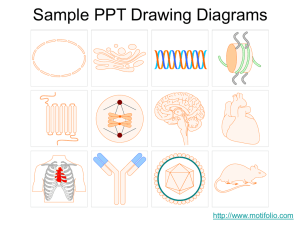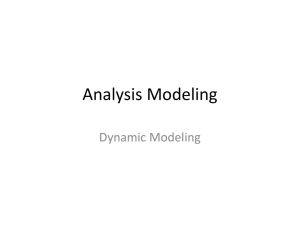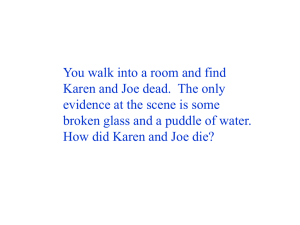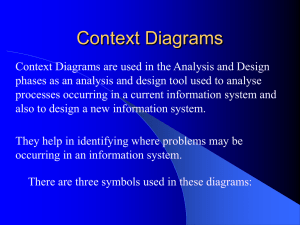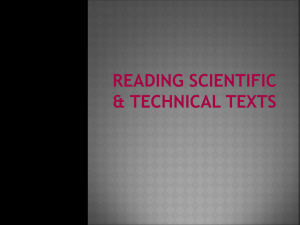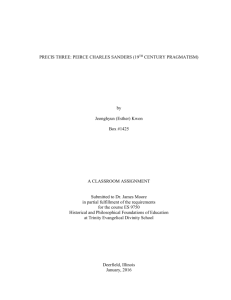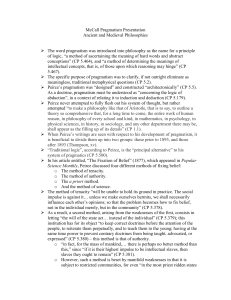Diagrams
advertisement
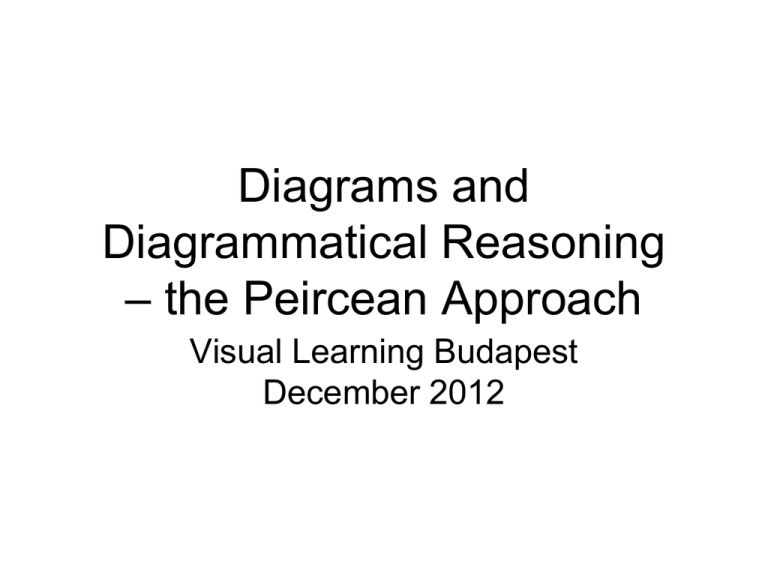
Diagrams and Diagrammatical Reasoning – the Peircean Approach Visual Learning Budapest December 2012 Diagrams in Cognitive Semiotics • Charles Peirce (1839-1914), the father of pragmatism and semiotics • His mature philosophy around 1900 contains a doctrine of diagrams and diagrammatical reasoning which attracts increasing interest • FS: Diagrammatology. An Investigation on the Borderlines of Phenomenology, Ontology, and Semiotics, Dordrecht: Springer 2007 Diagrams in Peirce’s taxonomy of signs Icon Index Image Diagram Metaphor Symbol Icon subtypes defined by sign use Image Diagram Metaphor So, the same sign vehicle may in some cases be used as different subtypes • Crescent shape as image of moon • Crescent shape as diagram for calculating ration between light and dark parts • Crescent shape as metaphor referring to moon, referring to the bread type of ”croissant” - or crescent shape referring to moon referring to islam Non-trivial icon definition • Icons generally defined by similarity between sign and object • ”For a great distinguishing property of the icon is that by the direct observation of it other truths concerning its object can be discovered than those which suffice to determine its construction” (Peirce 1895 CP 2.279) • This icon property is especially developed in diagrams Algebra of Logic • ” ... all deductive reason, even simple syllogism, involves an element of observation: namely, deduction consists in constructing an icon or diagram the relations of whose parts shall present a complete analogy with those of the parts of the object of reasoning, of experimenting upon this image in the imagination, and of observing the result so as to discover unnoticed and hidden relations among the parts.” (Peirce 1885, W5 164; CP 3.363 • Developed from his work on the first linear ”formal” representation of modern logic ... Typicality of diagrams • Diagram token (on the page, screen, imagination, etc.) VERSUS • Diagram type accessed through the token • “One contemplates the Diagram, and one at once prescinds from the accidental characters that have no significance.” (PAP, 1906, NEM IV, 317) • So, Diagrams offer the possibility of observing general relations -> Peirce’s philosophy of mathematics Diagrams: skelettal icons governed by symbols • Diagrams are types: the generality of diagram sign maps onto the generality of the object, indicated by accompanying symbols • Diagrams provide possibility for deductive thought experiments: ”A diagram is an icon or schematic image embodying the meaning of a general predicate: and from the observation of this icon we are supposed to construct a new general predicate.” (”New Elements”, NEM IV, 238) So, deduction is defined by the manipulation of ideal diagram models • Here, diagrams form a special case of a more general tendency, often overlooked: • Text and pictures only rarely appear isolated – in most cases they appear together, referring to the same object and supporting the same inference process regarding that object • Text and pictures may be isolated, of course, for special purposes Fur Diagram of the diagram reasoning process Cross-links in Peirce • Continuity (of diagram sheet) • Realism of possibilities (in diagram manipulation as in reality) • Diagrams in Abduction-DeductionInduction cycle • Pragmatic maxim (thought as experiment) • ”Symbols grow” ... Peirce as Enlightenment thinker Diagrams in reasoning: Abduction - deduction - induction • 1. Abduction Propose an explanatory diagram on the base of certain facts which are true if the diagram is true • 2. Deduction Experiment with the diagram charting some further necessary implications • 3. Induction Test the experiment results against facts support for 1. or revision of 1. -> Recursion Husserl parallels • Central notions addressing access and construction of theoretical objects are cognate to those around diagrams in Peirce: • Categorical intuition (Kategoriale Anschauung - neutral as to perception/ imagination) - LU, 1900-01 • Eidetic variation - Wesenserschauung, Ideenschau - E&U, 1938 • Problem: inaccessability of ”inexact essences” Venn diagrams ”Existential Graphs” - Peirce Diagrams as tools for Gedankenexperimente • Alpha Graph proof of Modus Ponens 1) Deiteration 2) Removal of ”ring” The diagram shows the first so-called Gamma Glimpse recorded by NASA’s SWIFTprogram Dec.17th 2004 - the largest energy bursts in the universe next to Big Bang. The Island of Robinson Crusoe (Daniel Defoe 1719) London Underground Map y = x2 • Different diagrams referring to same object Extension of diagram category • • • • Diagrams proper Logic Mathematics Grammar ... • Diagrams are all formalisms which allow for deduction • So, Diagrams are not confined to visual, graphical representations Synthetize facts - idealize Diagrams in police investigation: Jørn “Gamle” Holm Diagram reasoning in comics • The representation of events in Carl Barks: select catastrophic points princ. – Østergaard & Stjernfelt 2012 Varieties of diagrammatical reasoning • Corollarial vs. Theorematic Reasoning (terms stemming from Euclid) • Peirce’s ”first real discovery” (Carnegie application 1902) • Corollarial Reasoning fleshes out what already lay in the premisses (conforming to Kant’s idea that logic is tautological) • Theorematical Reasoning requires something further – a creative step requiring further description Corollarial vs. Theorematical ctd. Perimeter of square with side s Angle sum of triangle - requires the addition of auxiliary lines Theorematic reasoning • Requires ”something more” • The addition of particular auxiliary entities to the diagram – the selection of which entities? • A specific experiment with the diagram • Seeing the problem from a specific new perspective ... Generality of Corollarial vs. Theorematical “Peirce’s brilliant insight is that this geometrical distinction can be generalized to all deductive reasoning.” (Hintikka 1983), thereby throwing light upon the problem of logical incontinence or omniscience. The amount of auxiliary variables to be added in a problem is a “rough measure of its intriviality” which explains a large amount of cases where agents fail to realize the necessary implications of their assumptions. Hintikka “C.S. Peirce’s “First Real Discovery” and Its Contemporary Relevance”, in E. Freeman (ed.) The Relevance of Charles Peirce, 1983 Hintikka on two approaches to logic and language Language as Lingua Universalis (Frege, Russell, Wittgenstein, Quine Heidegger, structuralism, Derrida ...) Language as Calculus Ratiocinator (Boole, Peirce, Schröder, Hilbert, Gödel Husserl, Hintikka) The former leads to linguistic imperialism and relativism - the latter leads to semiotic pluralism and realism ... Cognitive Semiotics in Aarhus • 2-years International Elite MA Program • All courses in English • http://www.hum.au.dk/semiotics/ Experiment with diagram Eksperiment with diagram II Experiment with diagram III Experiment with diagram IV Dale Myers http://www.jfkfiles.com/jfk/html/ Experiment with diagram V


